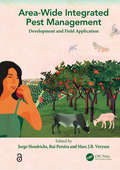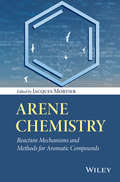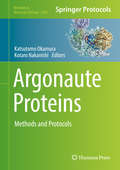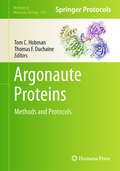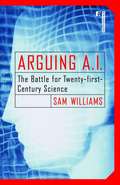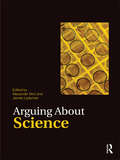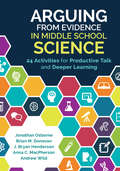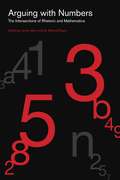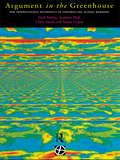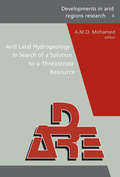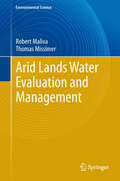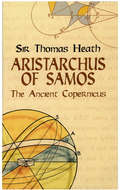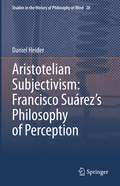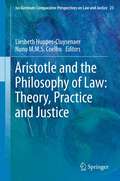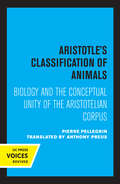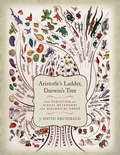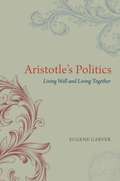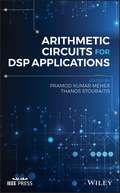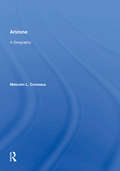- Table View
- List View
Area-wide Integrated Pest Management: Development and Field Application
by Jorge Hendrichs; Rui Pereira; Marc J.B. VreysenOver 98% of sprayed insecticides and 95% of herbicides reach a destination other than their target species, including non-target species, air, water and soil. The extensive reliance on insecticide use reduces biodiversity, contributes to pollinator decline, destroys habitat, and threatens endangered species. This book offers a more effective application of the Integrated Pest Management (IPM) approach, on an area-wide (AW) or population-wide (AW-IPM) basis, which aims at the management of the total population of a pest, involving a coordinated effort over often larger areas. For major livestock pests, vectors of human diseases and pests of high-value crops with low pest tolerance, there are compelling economic reasons for participating in AW-IPM. This new textbook attempts to address various fundamental components of AW-IPM, e.g. the importance of relevant problem-solving research, the need for planning and essential baseline data collection, the significance of integrating adequate tools for appropriate control strategies, and the value of pilot trials, etc. With chapters authored by 184 experts from more than 31 countries, the book includes many technical advances in the areas of genetics, molecular biology, microbiology, resistance management, and social sciences that facilitate the planning and implementing of area-wide strategies. The book is essential reading for the academic and applied research community as well as national and regional government plant and human/animal health authorities with responsibility for protecting plant and human/animal health.
Arena of Monsters (Escape from Planet Alcatraz)
by Michael DahlZak Nine has been captured and placed in Planet Alcatraz's "Monster Zoo." But this isn't any ordinary zoo. This zoo holds dozens of alien "monsters" who are forced to fight for the entertainment of the prison planet's owners. Zak's friend, Erro, is determined to break into the zoo to rescue the human boy. Erro will need to rely on his Quom survival skills to succeed. Will he be able to find Zak, avoid the zoo's Overseers, and find a way out?
Arene Chemistry
by Jacques MortierOrganized to enable students and synthetic chemists to understand and expand on aromatic reactions covered in foundation courses, the book offers a thorough and accessible mechanistic explanation of aromatic reactions involving arene compounds. * Surveys methods used for preparing arene compounds and their transformations * Connects reactivity and methodology with mechanism * Helps readers apply aromatic reactions in a practical context by designing syntheses * Provides essential information about techniques used to determine reaction mechanisms
Argonaute Proteins: Methods and Protocols (Methods in Molecular Biology #1680)
by Katsutomo Okamura Kotaro NakanishiThis volume covers methods that analyze various Argonaute proteins from a variety of organisms to help researchers better understand their properties ranging from a molecular level to an organismal level. The chapters in this book explore the following topics: identification and expression analysis of guide nucleic acids and their targets; analysis of biochemical properties of Argonautes; biological functions of Argonautes; and obtaining materials and setting up analysis platforms. Written in the highly successful Methods in Molecular Biology series format, chapters include introductions to their respective topics, lists of the necessary materials and reagents, step-by-step, readily reproducible laboratory protocols, and tips on troubleshooting and avoiding known pitfalls. Cutting-edge and authoritative, Argonaute Proteins: Methods and Protocols is a valuable resource for researchers and scientists looking to expand their knowledge of Argonaute proteins and their functions.
Argonaute Proteins: Methods and Protocols (Methods in Molecular Biology #725)
by Tom C. Hobman Thomas F. DuchaineWith the rapid proliferation of RNAi applications in basic and clinical sciences, the challenge has now become understanding how components of RNAi machinery function together in a regulated manner. Argonaute proteins are the central effectors of RNAi and are highly conserved among eukaryotes and some archaebacteria. These RNA-binding proteins use small guide RNAs to silence expression of genes at the mRNA and DNA levels. In Argonaute Proteins: Methods and Protocols, expert researchers in this burgeoning field provide detailed, up-to-date methods to study Argonaute protein functions and interactions in a wide variety of cell types ranging from yeast to mammalian systems, as well as in vitro. Written in the highly successful Methods in Molecular BiologyTM series format, chapters include brief introductions to their respective topics, lists of the necessary materials and reagents, step-by-step, readily reproducible laboratory protocols, and key tips on troubleshooting and avoiding known pitfalls. Practical and authoritative, Argonaute Proteins: Methods and Protocols serves as a vital reference for both experienced and novice scientists approaching the vast complexities of RNAi research.
Arguing A.I.: The Battle for Twenty-first Century Science
by Sam WilliamsFew scientific topics since the theory of biological evolution have inspired as much controversy as artificial intelligence has. Even now, fifty years after the term first made its appearance in academic journals, many philosophers and more than a few prominent scientists and software programmers dismiss the pursuit of thinking machines as the modern-day equivalent of medieval alchemists' hunt for the philosopher's stone--a pursuit based more on faith than on skeptical inquiry. In Arguing A.I., journalist Sam Williams charts both the history of artificial intelligence from its scientific and philosophical roots and the history of the A.I. debate. He examines how and why the tenor of the debate has changed over the last half-decade in particular, as scientists are struggling to take into account the latest breakthroughs in computer science, information technology, and human biology. For every voice predicting machines like 2001's HAL within the next twenty to thirty years, others have emerged with more pessimistic forecasts. From artificial intelligence's pioneers John McCarthy and Marvin Minsky, to futurist authors Ray Kurzweil and Hans Moravec, to software architects Bill Joy and Jaron Lanier,Arguing A. I. introduces readers to the people participating in the current debate, both proponents and critics of A.I. who are changing the way computers "think" and the way we think about computers. Ultimately, Arguing A.I. is as much a history of thought as it is a history of science. Williams notes that many of the questions plaguing modern scientists and software programmers are the same questions that have concerned scientists and philosophers since time immemorial: What are the fundamental limitations of science and scientific inquiry? What is the nature of intelligence? And, most important, what does it really mean to be human?
Arguing About Science (Arguing About Philosophy)
by James Ladyman Alexander BirdArguing About Science is an outstanding, engaging introduction to the essential topics in philosophy of science, edited by two leading experts in the field. This exciting and innovative anthology contains a selection of classic and contemporary readings that examine a broad range of issues, from classic problems such as scientific reasoning; causation; and scientific realism, to more recent topics such as science and race; forensic science; and the scientific status of medicine. The editors bring together some of the most influential contributions of famous philosophers in the field, including John Stuart Mill and Karl Popper, as well as more recent extracts from philosophers and scientists such as Ian Hacking, Stephen Jay Gould, Bas van Fraassen, Nancy Cartwright, and John Worrall. The anthology is organised into nine clear sections: science, non science and pseudo-science race, gender and science scientific reasoning scientific explanation laws and causation science and medicine probability and forensic science risk, uncertainty and science policy scientific realism and anti-realism. The articles chosen are clear, interesting, and free from unnecessary jargon. The editors provide lucid introductions to each section in which they provide an overview of the debate, as well as suggestions for further reading.
Arguing From Evidence in Middle School Science: 24 Activities for Productive Talk and Deeper Learning
by Brian M. Donovan Anna C. MacPherson Andrew J. Wild Jonathan Francis Osborne J. (Joseph) HendersonTeaching your students to think like scientists starts here! If you’ve ever struggled to help students make scientific arguments from evidence, this practical, easy-to-use activity book is for you! Give your students the critical scientific practice today′s science standards require. You’ll discover strategies and activities to effectively engage students in arguments about competing data sets, opposing scientific ideas, applying evidence to support specific claims, and more. 24 ready-to-implement activities drawn from the physical sciences, life sciences, and earth and space sciences help teachers to: Align lessons to the Next Generation Science Standards (NGSS) Engage students in the 8 NGSS science and engineering practices Establish rich, productive classroom discourse Facilitate reading and writing strategies that align to the Common Core State Standards Extend and employ argumentation and modeling strategies Clarify the difference between argumentation and explanation Includes assessment guidance and extension activities. Learn to teach the rational side of science the fun way with this simple and straightforward guide!
Arguing From Evidence in Middle School Science: 24 Activities for Productive Talk and Deeper Learning
by Brian M. Donovan Anna C. MacPherson Andrew J. Wild Jonathan Francis Osborne J. (Joseph) HendersonTeaching your students to think like scientists starts here! If you’ve ever struggled to help students make scientific arguments from evidence, this practical, easy-to-use activity book is for you! Give your students the critical scientific practice today′s science standards require. You’ll discover strategies and activities to effectively engage students in arguments about competing data sets, opposing scientific ideas, applying evidence to support specific claims, and more. 24 ready-to-implement activities drawn from the physical sciences, life sciences, and earth and space sciences help teachers to: Align lessons to the Next Generation Science Standards (NGSS) Engage students in the 8 NGSS science and engineering practices Establish rich, productive classroom discourse Facilitate reading and writing strategies that align to the Common Core State Standards Extend and employ argumentation and modeling strategies Clarify the difference between argumentation and explanation Includes assessment guidance and extension activities. Learn to teach the rational side of science the fun way with this simple and straightforward guide!
Arguing to Solve a Mystery
by Emily Gibson Tessaly Jen Meghan Comstock Andrew FalkNIMAC-sourced textbook
Arguing with Numbers: The Intersections of Rhetoric and Mathematics (RSA Series in Transdisciplinary Rhetoric #16)
by James Wynn G. Mitchell ReyesAs discrete fields of inquiry, rhetoric and mathematics have long been considered antithetical to each other. That is, if mathematics explains or describes the phenomena it studies with certainty, persuasion is not needed. This volume calls into question the view that mathematics is free of rhetoric. Through nine studies of the intersections between these two disciplines, Arguing with Numbers shows that mathematics is in fact deeply rhetorical. Using rhetoric as a lens to analyze mathematically based arguments in public policy, political and economic theory, and even literature, the essays in this volume reveal how mathematics influences the values and beliefs with which we assess the world and make decisions and how our worldviews influence the kinds of mathematical instruments we construct and accept. In addition, contributors examine how concepts of rhetoric—such as analogy and visuality—have been employed in mathematical and scientific reasoning, including in the theorems of mathematical physicists and the geometrical diagramming of natural scientists. Challenging academic orthodoxy, these scholars reject a math-equals-truth reduction in favor of a more constructivist theory of mathematics as dynamic, evolving, and powerfully persuasive. By bringing these disparate lines of inquiry into conversation with one another, Arguing with Numbers provides inspiration to students, established scholars, and anyone inside or outside rhetorical studies who might be interested in exploring the intersections between the two disciplines.In addition to the editors, the contributors to this volume are Catherine Chaput, Crystal Broch Colombini, Nathan Crick, Michael Dreher, Jeanne Fahnestock, Andrew C. Jones, Joseph Little, and Edward Schiappa.
Arguing with Numbers: The Intersections of Rhetoric and Mathematics (RSA Series in Transdisciplinary Rhetoric)
by James Wynn G. Mitchell ReyesAs discrete fields of inquiry, rhetoric and mathematics have long been considered antithetical to each other. That is, if mathematics explains or describes the phenomena it studies with certainty, persuasion is not needed. This volume calls into question the view that mathematics is free of rhetoric. Through nine studies of the intersections between these two disciplines, Arguing with Numbers shows that mathematics is in fact deeply rhetorical. Using rhetoric as a lens to analyze mathematically based arguments in public policy, political and economic theory, and even literature, the essays in this volume reveal how mathematics influences the values and beliefs with which we assess the world and make decisions and how our worldviews influence the kinds of mathematical instruments we construct and accept. In addition, contributors examine how concepts of rhetoric—such as analogy and visuality—have been employed in mathematical and scientific reasoning, including in the theorems of mathematical physicists and the geometrical diagramming of natural scientists. Challenging academic orthodoxy, these scholars reject a math-equals-truth reduction in favor of a more constructivist theory of mathematics as dynamic, evolving, and powerfully persuasive. By bringing these disparate lines of inquiry into conversation with one another, Arguing with Numbers provides inspiration to students, established scholars, and anyone inside or outside rhetorical studies who might be interested in exploring the intersections between the two disciplines.In addition to the editors, the contributors to this volume are Catherine Chaput, Crystal Broch Colombini, Nathan Crick, Michael Dreher, Jeanne Fahnestock, Andrew C. Jones, Joseph Little, and Edward Schiappa.
Argument in the Greenhouse: The International Economics of Controlling Global Warming (Global Environmental Change Ser.)
by Stephen Hall Clare Smith Sujata Gupta Nick MabeyHow can greenhouse gases be controlled and reduced? Will it be in time? This book adds a significant new contribution to the crucial climate change/global warming debate. Incorporating the key political and legal considerations into `real world' applied economic analysis, the authors provide a unique focus on the wider political economy of the problem. All the key issues of controlling climate change (costs, timing and degree of stabilisation, ecological taxt reform, developing countries, and evolution of international agreements), are placed firmly within the current legal and political context, with state-of-the-art economic techniques introduced to analyse different policy proposals. Covering both the developing and developed world, this book identifies important new policies to foster effective agreements on eissions and prevent global warming - realistic policies, likely to receive support at both international and domestic levels. be in time? This book adds a significant new contribution to the crucial climate change/global warming debate. Incorporating the key political and legal considerations into 'real world' applied economic analysis, the book's authors provide a unique focus on the wider political economy of the problem. All the key issues of controlling climate change (costs, timing and degree of stabilisation, ecological tax reform, developing countries and evolution of international agreements), are placed firmly within the current legal and political economy context, with state-of-the-art economic techniques introduced to analyse different policy proposals. Covering both the developing and developed world, this book identifies important new policies to foster effective agreements on emmissions and prevent global warming - realistic policies which are likely to receive support at both international and domestic levels.
Arid Land Hydrogeology: Proceedings of the Third Joint UAE-Japan Symposium on Sustainable GCC Environment and Water Resources (EWR2006), 28 - 30 January 2006, Abu Dhabi, UAE (Volume IV in DARE series) (Developments in Arid Regions Research Series)
by A.M.O. MohamedThere are many urgent problems in arid land hydrogeology and it is these issues which are tackled in this volume on desert environments. The UAE-Japan symposia provide a venue for the exchange of expertise, confronting such problems as purification, usage and management of groundwater, the assessment and protection of sustainable water resources, a
Arid Lands Water Evaluation and Management (Environmental Science and Engineering)
by Robert Maliva Thomas MissimerA large part of the global population lives in arid lands which have low rainfall and often lack the water required for sustainable population and economic growth. This book presents a comprehensive description of the hydrogeology and hydrologic processes at work in arid lands. It describes the techniques that can be used to assess and manage the water resources of these areas with an emphasis on groundwater resources, including recent advances in hydrologic evaluation and the differences between how aquifer systems behave in arid lands versus more humid areas. Water management techniques are described and summarized to show how a more comprehensive approach to water management is required in these areas, including the need to be aware of cultural sensitivities and conditions unique to many arid regions. The integration of existing resources with the addition of new water sources, such as desalination of brackish water and seawater, along with reusing treated wastewater, will be required to meet future water supply needs. Also, changing climatic conditions will force water management systems to be more robust so that future water supply demands can be met as droughts become more intense and rainfall events become more intense. A range of water management techniques are described and discussed in order to illustrate the methods for integrating these measures within the context of arid lands conditions.
Aristarchus of Samos: The Ancient Copernicus
by Thomas Heath"A most welcome addition to the literature of astronomical history." -- Nature"A most important contribution to the early history of Greek thought and a notable monument of English scholarship." -- Journal of Hellenic StudiesThis classic work traces Aristarchus of Samos's anticipation by two millennia of Copernicus's revolutionary theory of the orbital motion of the earth. Heath's history of astronomy ranges from Homer and Hesiod to Aristarchus and includes quotes from numerous thinkers, compilers, and scholasticists from Thales and Anaximander through Pythagoras, Plato, Aristotle, and Heraclides. 34 figures.
Aristotelian Subjectivism: Francisco Suárez’s Philosophy of Perception (Studies in the History of Philosophy of Mind #28)
by Daniel HeiderThis monograph presents new material on Francisco Suárez’s comprehensive theory of sense perception. The core theme is perceptual intentionality in Suárez’s theory of the senses, external and internal, as presented in his Commentaria una cum quaestionibus in libros Aristotelis De anima published in 1621. The author targets the question of the multistage genesis of perceptual acts by considering the ontological “items” involved in the procession of sensory information. However, the structural issue is not left aside, and the nature of the relationship due to which our perceptions are mental representations of this or that object is also considered. The heuristic historiographical background includes not only the theories of classical authors, such as Aristotle and Aquinas, but also those of late medieval authors of the fourteenth century. These are headed by John Duns Scotus, John of Jandun, Peter Auriol and Peter John Olivi. Readers will discover the differences between Suárez’s and Aquinas’s views, as well as other sources that may have served as positive inspiration for the Jesuit’s theory. By considering the late medieval philosophy of the fourteenth century, this book helps, to a certain extent, to fill a gap in the historiography of philosophy regarding the link between late medieval and early modern scholasticism. In the first part of the book, the metaphysics of the soul and powers is considered. Chapters on the external senses follow, covering topics such as the sensible species, the causes of sensation, self-awareness, and the ordering of the external senses. A further chapter is devoted to the internal senses and the author argues that by reducing the number and functional scope of the interior senses Suárez deepens the gap between the external senses and the intellect, but he reduces it through emphasizing the unifying efficacy of the soul.This book brings a synthetic and unifying perspective to contemporary research and will particularly appeal to graduate students and researchers in theology and philosophy, especially philosophy of mind.
Aristotle and The Philosophy of Law: Theory, Practice And Justice (Ius Gentium: Comparative Perspectives on Law and Justice #23)
by Nuno M.M.S. Coelho Liesbeth Huppes-CluysenaerThe book presents a new focus on the legal philosophical texts of Aristotle, which offers a much richer frame for the understanding of practical thought, legal reasoning and political experience. It allows understanding how human beings interact in a complex world, and how extensive the complexity is which results from humans' own power of self-construction and autonomy. The Aristotelian approach recognizes the limits of rationality and the inevitable and constitutive contingency in Law. All this offers a helpful instrument to understand the changes globalisation imposes to legal experience today. The contributions in this collection do not merely pay attention to private virtues, but focus primarily on public virtues. They deal with the fact that law is dependent on political power and that a person can never be sure about the facts of a case or about the right way to act. They explore the assumption that a detailed knowledge of Aristotle's epistemology is necessary, because of the direct connection between Enlightened reasoning and legal positivism. They pay attention to the concept of proportionality, which can be seen as a precondition to discuss liberalism.
Aristotle on Time
by Tony RoarkAristotle's definition of time as 'a number of motion with respect to the before and after' has been branded as patently circular by commentators ranging from Simplicius to W. D. Ross. In this book Tony Roark presents an interpretation of the definition that renders it not only non-circular, but also worthy of serious philosophical scrutiny. He shows how Aristotle developed an account of the nature of time that is inspired by Plato while also thoroughly bound up with Aristotle's sophisticated analyses of motion and perception. When Aristotle's view is properly understood, Roark argues, it is immune to devastating objections against the possibility of temporal passage articulated by McTaggart and other 20th century philosophers. Roark's novel and fascinating interpretation of Aristotle's temporal theory will appeal to those interested in Aristotle, ancient philosophy and the philosophy of time.
Aristotle's Classification of Animals: Biology and the Conceptual Unity of the Aristotelian Corpus
by Pierre PellegrinThis title is part of UC Press's Voices Revived program, which commemorates University of California Press’s mission to seek out and cultivate the brightest minds and give them voice, reach, and impact. Drawing on a backlist dating to 1893, Voices Revived makes high-quality, peer-reviewed scholarship accessible once again using print-on-demand technology. This title was originally published in 1986.
Aristotle's Ladder, Darwin's Tree: The Evolution of Visual Metaphors for Biological Order
by J. David ArchibaldLeading paleontologist J. David Archibald explores the rich history of visual metaphors for biological order from ancient times to the present and their influence on humans' perception of their place in nature, offering uncommon insight into how we went from standing on the top rung of the biological ladder to embodying just one tiny twig on the tree of life. He begins with the ancient but still misguided use of ladders to show biological order, moving then to the use of trees to represent seasonal life cycles and genealogies by the Romans. The early Christian Church then appropriated trees to represent biblical genealogies. The late eighteenth century saw the tree reclaimed to visualize relationships in the natural world, sometimes with a creationist view, but in other instances suggesting evolution. Charles Darwin's On the Origin of Species (1859) exorcised the exclusively creationist view of the "tree of life," and his ideas sparked an explosion of trees, mostly by younger acolytes in Europe. <P><P> Although Darwin's influence waned in the early twentieth century, by midcentury his ideas held sway once again in time for another and even greater explosion of tree building, generated by the development of new theories on how to assemble trees, the birth of powerful computing, and the emergence of molecular technology. Throughout Archibald's far-reaching study, and with the use of many figures, the evolution of "tree of life" iconography becomes entwined with our changing perception of the world and ourselves.
Aristotle's Politics: Living Well and Living Together
by Eugene Garver“Man is a political animal,” Aristotle asserts near the beginning of the Politics. In this novel reading of one of the foundational texts of political philosophy, Eugene Garver traces the surprising implications of Aristotle’s claim and explores the treatise’s relevance to ongoing political concerns. Often dismissed as overly grounded in Aristotle’s specific moment in time, in fact the Politics challenges contemporary understandings of human action and allows us to better see ourselves today. Close examination of Aristotle’s treatise, Garver finds, reveals a significant, practical role for philosophy to play in politics. Philosophers present arguments about issues—such as the right and the good, justice and modes of governance, the relation between the good person and the good citizen, and the character of a good life—that politicians must then make appealing to their fellow citizens. Completing Garver’s trilogy on Aristotle’s unique vision, Aristotle’s Politics yields new ways of thinking about ethics and politics, ancient and modern.
Arithmetic Circuits for DSP Applications
by Thanos Stouraitis Pramod Kumar MeherA comprehensive guide to the fundamental concepts, designs, and implementation schemes, performance considerations, and applications of arithmetic circuits for DSP Arithmetic Circuits for DSP Applications is a complete resource on arithmetic circuits for digital signal processing (DSP). It covers the key concepts, designs and developments of different types of arithmetic circuits, which can be used for improving the efficiency of implementation of a multitude of DSP applications. Each chapter includes various applications of the respective class of arithmetic circuits along with information on the future scope of research. Written for students, engineers, and researchers in electrical and computer engineering, this comprehensive text offers a clear understanding of different types of arithmetic circuits used for digital signal processing applications. The text includes contributions from noted researchers on a wide range of topics, including a review of circuits used in implementing basic operations like additions and multiplications; distributed arithmetic as a technique for the multiplier-less implementation of inner products for DSP applications; discussions on look up table-based techniques and their key applications; CORDIC circuits for calculation of trigonometric, hyperbolic and logarithmic functions; real and complex multiplications, division, and square-root; solution of linear systems; eigenvalue estimation; singular value decomposition; QR factorization and many other functions through the use of simple shift-add operations; and much more. This book serves as a comprehensive resource, which describes the arithmetic circuits as fundamental building blocks for state-of-the-art DSP and reviews in - depth the scope of their applications.
Ariviyal (Science) 10th Standard - Tamilnadu Board
by Training State Council of Educational ResearchAriviyal (Science) Textbook for the 10th Standard Students, preparing for Tamil Nadu State Board Exam.
Arizona
by Malcolm L. ComeauxThis systematic study of the geography of Arizona emphasizes the relationship between the human population and the environment-the patterns of human activities and their effects on the landscape. Dr. Comeaux introduces Arizona's physical features, then traces its history from the time of the early Indians. A discussion of the state's contemporary population and the rapid growth of its cities is followed by a geographic approach to a number of key topics: Arizona's industries-manufacturing, mining, agriculture, lumber, ranching, and tourism-water and land use, and recreation.
